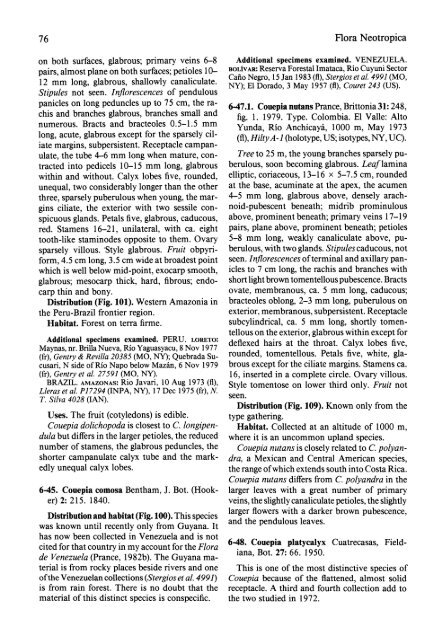flora neotropica - CNCFlora
flora neotropica - CNCFlora
flora neotropica - CNCFlora
Create successful ePaper yourself
Turn your PDF publications into a flip-book with our unique Google optimized e-Paper software.
76<br />
on both surfaces, glabrous; primary veins 6-8<br />
pairs, almost plane on both surfaces; petioles 10-<br />
12 mm long, glabrous, shallowly canaliculate.<br />
Stipules not seen. Inflorescences of pendulous<br />
panicles on long peduncles up to 75 cm, the rachis<br />
and branches glabrous, branches small and<br />
numerous. Bracts and bracteoles 0.5-1.5 mm<br />
long, acute, glabrous except for the sparsely ciliate<br />
margins, subpersistent. Receptacle campanulate,<br />
the tube 4-6 mm long when mature, contracted<br />
into pedicels 10-15 mm long, glabrous<br />
within and without. Calyx lobes five, rounded,<br />
Flora Neotropica<br />
Additional specimens examined. VENEZUELA.<br />
BOLIVAR: Reserva Forestal Imataca, Rio Cuyuni Sector<br />
Caiio Negro, 15 Jan 1983 (fl), Stergios et al. 4991 (MO,<br />
NY); El Dorado, 3 May 1957 (fl), Couret 243 (US).<br />
647.1. Couepia nutans Prance, Brittonia 31: 248,<br />
fig. 1. 1979. Type. Colombia. El Valle: Alto<br />
Yunda, Rio Anchicaya, 1000 m, May 1973<br />
(fl), HiltyA-1 (holotype, US; isotypes, NY, UC).<br />
Tree to 25 m, the young branches sparsely pu-<br />
berulous, soon becoming glabrous. Leaf lamina<br />
elliptic, coriaceous, 13-16 x 5-7.5 cm, rounded<br />
at the base, acuminate at the apex, the acumen<br />
4-5 mm long, glabrous above, densely arach-<br />
noid-pubescent beneath; midrib prominulous<br />
above, prominent beneath; primary veins 17-19<br />
pairs, plane above, prominent beneath; petioles<br />
5-8 mm long, weakly canaliculate above, pu-<br />
unequal, two considerably longer than the other<br />
three, sparsely puberulous when young, the margins<br />
ciliate, the exterior with two sessile conspicuous<br />
glands. Petals five, glabrous, caducous,<br />
red. Stamens 16-21, unilateral, with ca. eight<br />
tooth-like staminodes opposite to them. Ovary<br />
sparsely villous. Style glabrous. Fruit obpyri- berulous, with two glands. Stipules caducous, not<br />
form, 4.5 cm long, 3.5 cm wide at broadest point seen. Inflorescences of terminal and axillary panwhich<br />
is well below mid-point, exocarp smooth, icles to 7 cm long, the rachis and branches with<br />
glabrous; mesocarp thick, hard, fibrous; endo- short light brown tomentellous pubescence. Bracts<br />
carp thin and bony.<br />
ovate, membranous, ca. 5 mm long, caducous;<br />
Distribution (Fig. 101). Western Amazonia in bracteoles oblong, 2-3 mm long, puberulous on<br />
the Peru-Brazil frontier region.<br />
exterior, membranous, subpersistent. Receptacle<br />
Habitat. Forest on terra firme.<br />
subcylindrical, ca. 5 mm long, shortly tomentellous<br />
on the exterior, glabrous within except for<br />
Additional specimens examined. PERU. LORETO:<br />
Maynas, nr. Brilla Nueva, Rio Yaguasyacu, 8 Nov 1977<br />
deflexed hairs at the throat. Calyx lobes five,<br />
(fr), Gentry & Revilla 20385 (MO, NY); Quebrada Su- rounded, tomentellous. Petals five, white, glacusari,<br />
N side of Rio Napo below Mazan, 6 Nov 1979 brous except for the ciliate margins. Stamens ca.<br />
(fr), Gentry et al. 27591 (MO, NY).<br />
16, inserted in a complete circle. Ovary villous.<br />
BRAZIL. AMAZONAS: Rio Javari, 10 Aug 1973 (fl),<br />
Lleras et al. P17294 (INPA, NY), 17 Dec 1975 (fr), N.<br />
Style tomentose on lower third only. Fruit not<br />
T. Silva 4028<br />
seen.<br />
(IAN).<br />
Distribution (Fig. 109). Known only from the<br />
Uses. The fruit (cotyledons) is edible. type gathering.<br />
Couepia dolichopoda is closest to C. longipen- Habitat. Collected at an altitude of 1000 m,<br />
dula but differs in the larger petioles, the reduced where it is an uncommon upland species.<br />
number of stamens, the glabrous peduncles, the Couepia nutans is closely related to C. polyanshorter<br />
campanulate calyx tube and the mark- dra, a Mexican and Central American species,<br />
edly unequal calyx lobes.<br />
the range of which extends south into Costa Rica.<br />
Couepia nutans differs from C. polyandra in the<br />
6-45. Couepia comosa Bentham, J. Bot. (Hook- larger leaves with a great number of primary<br />
er) 2: 215. 1840.<br />
veins, the slightly canaliculate petioles, the slightly<br />
Distribution and habitat (Fig. 100). This larger flowers with a darker brown pubescence,<br />
species<br />
and the<br />
was known until recently only from Guyana. It pendulous leaves.<br />
has now been collected in Venezuela and is not<br />
cited for that country in<br />
6-48.<br />
my account for the Flora Couepia platycalyx Cuatrecasas, Fieldde<br />
Venezuela (Prance, 1982b). The Guyana ma- iana, Bot. 27: 66. 1950.<br />
terial is from rocky places beside rivers and one This is one of the most distinctive species of<br />
of the Venezuelan collections (Stergios et al. 4991) Couepia because of the flattened, almost solid<br />
is from rain forest. There is no doubt that the receptacle. A third and fourth collection add to<br />
material of this distinct species is conspecific. the two studied in 1972.

















